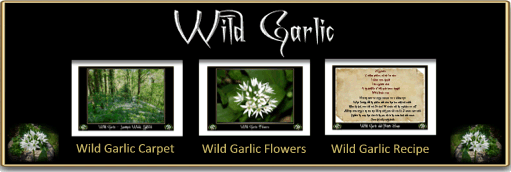
“Eate leeks in Lide and ransons in May
And all yeare after physicians my play.”
Wander through any Dartmoor woodland or along a hedgerow between April and June and you cannot fail to miss the heady aroma of garlic – the warmer the day the stronger the smell. Unless one knows from whence it emanates the exact source may be something of a mystery. However, not far away will probably be a carpet of small, white star-shaped flowers which belong to the Wild Garlic or as it’s sometimes known – Ranson or Ransley. The word ranson is actually derived from the old Anglo-Saxon word hramsa meaning garlic, Clarke Hall, p.191, this in turn has mutated to ranson then locally ramson. This in theory should give an indication of how long the plant has been recognised. Locally there are no place-names associated with either Wild Garlic or Ransons. there is Ramshorn Down but that refers to the male sheep. The earliest evidence of people using Wild Garlic comes from a Neolithic settlement in Switzerland where extraordinarily high pollen traces were found.
To be more precise the Latin name for the plant is Allium ursinum which in the context of Dartmoor is slightly odd. The etymology of the Latin name element ursinum (Ursa as in bear) is said to relate to the plant being a popular food source for the Brown Bear. Although a bear’s skin has recently been discovered in the Bronze Age kist on Whitehorse Hill I don’t think any have been digging up Wild Garlic on Dartmoor for a good long time.
As Wild Garlic is very closely related to chives and it has numerous herbal and medicinal properties. The leaves are best used throughout the late Spring and Summer months and even the flowers are edible but the later they are picked then the stronger the taste. The tiny bulbs can be used in the same way as normal garlic but they tend not to be as flavoursome.
As far as recipes go the leaves can be used in anything from salads to sandwiches and soups to sauces. A quick look on Google for ‘wild garlic recipes’ will turn up numerous culinary uses for the plant. The other big benefit of using Wild Garlic is that apart from spending time finding it everything that comes after is free thanks to ‘Nature’s Larder’. One of my favourites is Wild Garlic and Potato soup, the recipe for which can be found below.
The other delicacy which is out of this world is the Cornish Yarg cheese wrapped in Wild Garlic leaves and is now made by the Lynher Dairies Cheese Co. Ltd. Incidentally if you have ever come across Yarg cheese before and wondered how it got its name? Simple, the cheese was first made at a farm on Bodmin Moor which was owned by Alan Gray. Now spell his name backwards and you arrive at ‘Yarg’.
There is also a company in Norfolk called Bray’s Cottage Pork Pies which amongst other things make Wild Garlic pork pies, I have never tried one but they sound delicious.
Wild Garlic leaves are very attractive to browsing cattle and Aberystwyth University are even advocating adding garlic to the cattle feed in order to reduce there Global Warming emissions. However, there is one slight problem with dairy cows, it will make the milk taste of garlic. This is one reason dairy farmers are not too keen to see it in the hedgerows where their cattle graze.

Medicinally Wild Garlic possesses many of the attributes of cultivated garlic although it tends to be slightly weaker and is high in vitamin C. Hold your breath, here are its properties: antiastmatic, anticholesterolemic, antiseptic, astringent, diuretic, expectorant and hypotensive to name but a few. Traditionally the plant was used to ease stomach pain, treat diarrhoea, colic, flatulence, indigestion and appetite loss. It was also used for treating asthma, bronchitis and emphysema. Topically applied Wild Garlic was used to treat rheumatic and arthritic joint pains.
Another well-known property of Wild Garlic is that it acts as an anthelmintic or in other words it is supposed to kill parasitic worms. In humans the most common was/is the threadworm which causes anal irritation and is commonly seen in children. It is also used as a ‘natural’ wormer for horses although its efficacy is very doubtful.
A few of the more slightly off the wall uses for Wild Garlic was that it was said to draw moles from the ground into awaiting traps and to make cocks more aggressive when fighting. Should a child come down with measles one simply wrapped nine lined bandages coated with crushed bulbs around the itchy unfortunate and leave it there for nine days. When the period of treatment was over the linen bandages needed to be buried in the garden and the measles would be cured. Needless to say that in a normal healthy child the symptoms should abate after 7 – 10 days anyway which coincidentally coincides with the above treatment period. Although there is no evidence of this on Dartmoor another concoction called ‘vinegar of the four thieves’ was used by some people during plague outbreaks. This protected the scumbags who robbed the houses of plague victims from being infected.
Carpets of Wild Garlic growing in woodland is a sign that its growing in ancient woodland, indeed the plant is used as an AWI or Ancient Woodland Indicator species.
One final word of warning, Wild Garlic looks very similar to Lily of the Valley especially if you aren’t wearing your glasses. There have been a few fatalities of people mistaking Lily of the Valley for Wild Garlic and then eating it. Lily of the Valley is one very poisonous and unforgiving plant

Clarke-Hall, J. R. 2004. A Concise Anglo-Saxon Dictionary. London: Toronto Press.
 Legendary Dartmoor The many aspects past and present of Dartmoor
Legendary Dartmoor The many aspects past and present of Dartmoor
